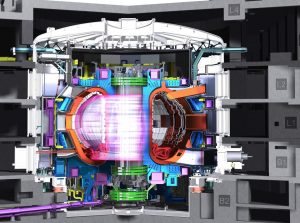In just a few decades, we could see fusion reactors become an economically viable method of electricity production.
According to new research conducted by Durham University and Culham Centre for Fusion Energy in Oxfordshire, due to recent advances in superconductor technology, a fusion power station is actually a financially feasible method of fusion energy production in comparison to traditional fission nuclear power and they should start being built.
The research, published in the journal Fusion Engineering and Design, builds on earlier findings that a fusion power plant could generate electricity at a similar price to a fission plant and identifies new advantages in using the new superconductor technology.
“Obviously we have had to make assumptions, but what we can say is that our predictions suggest that fusion won’t be vastly more expensive than fission,” said Professor Damian Hampshire of the Centre for Material Physics at Durham University.

What this really means is that within two generations, fusion reactors could offer an almost unlimited supply of energy without contributing to global warming or producing large quantities of hazardous products.
Fusion reactors generate electricity by heating plasma to around 100 million degrees centigrade so that hydrogen atoms fuse together and then release energy. This differs from fission reactors which work by splitting atoms at much lower temperatures.
The use of fusion reactors instead of current methods of fission reactors means there would be no radioactive waste since they are safer, producing no high level radioactive material to potentially leak into the environment.
We’re about 10 years away from seeing a test fusion reactor, the International Thermonuclear Experimental Reactor, from operating in the South of France. Once running it will aim to prove the scientific and technological feasibility of fusion energy.
“Fission, fusion or fossil fuels are the only practical options for reliable large-scale base-load energy sources. Calculating the cost of a fusion reactor is complex, given the variations in the cost of raw materials and exchange rates. However, this work is a big step in the right direction” said Hampshire.
“We have known about the possibility of fusion reactors for many years but many people did not believe that they would ever be built because of the technological challenges that have had to be overcome and the uncertain costs.”
“While there are still some technological challenges to overcome we have produced a strong argument, supported by the best available data, that fusion power stations could soon be economically viable. We hope this kick-starts investment to overcome the remaining technological challenges and speeds up the planning process for the possibility of a fusion-powered world.”
The report, which was commissioned by Research Council UK’s Energy Programme focuses on recent advances in high temperature superconductors. These materials could be used to construct the powerful magnets that keep the hot plasma in position inside the containing vessel, known as a tokamak, at the heart of a fusion reactor.
What this means for superconductors and why we care
These advancements also have an impact on superconducting magnets. They would be able to be built in sections rather than in one piece meaning that maintenance would be much cheaper because individual sections of the magnet could be withdrawn for repair or replacement rather than the whole device.

